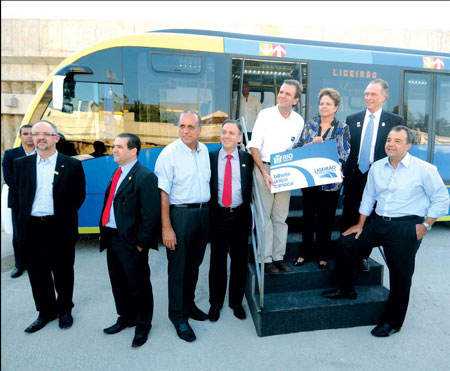Urban transport still Rio's toughest challenge
Updated: 2012-04-30 07:35
(China Daily)
|
|||||||||||
|
Brazilian President Dilma Rousseff (third right), Rio de Janeiro Governor Sergio Cabral (first right), Mayor Eduardo Paes (fourth right) and Brazilian Olympic Committee Chairman Carlos Arthur Nuzman (second right) unveil the Transcarioca BRT. Joo Paulo Engelbrecht / Rio City Hall |

Sustainable transportation needed as Brazil gears up for World Cup, Olympics
As Brazil readies itself to host the world's two largest sporting contests, its leaders realize the importance of having the right infrastructure in place to sustain growth and handle the transportation of goods and people these events will demand.
At a first glance, it seems as though Brazil's sudden success has taken the nation by surprise. Though Brazil's selection as the host for the World Cup and the 2016 Olympic Games confirms the country's status a rising power, it lags behind in terms of investment in and the management of transport infrastructure and systems.
However, money has been set aside and work is now well underway to create nationwide transportation infrastructure designed to not only accommodate the influx of visitors in 2014 and 2016, but also to provide for the country's transportation needs well into the future.
Brazil's federal government has set aside $4.3 billion for urban transportation infrastructure, and state and local authorities have committed a further $2.15 billion, bringing the total to be spent on urban transport to almost $6.5 billion.
It is also thought that private investment will come on board and increase the total figure to be spent.
Across the country, Bus Rapid Transit, or BRT, systems have been identified as the most suitable option for addressing the challenge of investing in and improving the nation's urban transportation infrastructure.
To date, only half of the projects have started the construction phase, while construction has been finished on only one of the projects, which is located in Uberlndia in the western part of the state of Minas Gerais.
Brazil needs to pick up the pace of the projects, though it is estimated that the construction phase of all the projects will come to an end by 2014.
The country has agreed that the BRT projects are necessary, and when completed, they will bring benefits to the municipalities they serve, the nation's leaders say.
Nobody is more optimistic about the prospects of BRT than Toni Lindau, director of the Center for Sustainable Transport in Brazil (CTS-Brasil), part of the international EMBARQ network, whose mission is to catalyze and help implement environmentally and financially sustainable transportation solutions to improve quality of life in cities.
"This is a critical time for mega-cities all over the world. All cities face the same burden of rapid motorization and population growth," he claimed in a message to followers last year.
He is even clearer about why Brazil needs the BRT. "All of the projects are envisioned as long-term infrastructure improvements. I noticed that in previous host countries some of the projects, such as the park-and-ride transport project, only lasted as long as the World Cup. In Brazil, we're planning on fully investing in lasting transportation improvements, not quick-fix projects," he added.
The Rio solution
There is perhaps nowhere in Brazil where transportation challenges are more compounded than in Rio de Janeiro, and its current lack of infrastructure is its most serious problem.
However, the hope is that BRT will be a lasting solution for the city's inhabitants and the millions of visitors estimated to arrive in the city in 2014 and 2016.
Rio has a population of more than 6.3 million living within a city boundary of 1,200 square kilometers. In its densely populated neighborhoods, there are more than 2.2 million vehicles operating on a daily basis, and more than 4.3 million trips are made using public transport, which includes a fleet of 11,000 buses.
Furthermore, the city's Maracan stadium will host seven matches of the 2014 Soccer World Cup, including the final, and much of the 2016 Olympics will be held in and around the stadium.
Current traffic management schemes used at local soccer matches will not be good enough for these global events, so BRT projects have been established to address the shortcomings and deliver on development needs over a longer period of time.
Lindau explained: "In Rio, there are already plans for three new BRT systems, including some in areas that currently have no public transport."
These plans include new dedicated bus lines covering a total of 150 kilometers on three routes -Transoeste, Transcarioca and Transolmpica. The routes will be inaccessible to cars and other private vehicles and will cut journey times by more than 75 percent.
The city decided on a BRT system because it was quicker to build and up to 10 times cheaper than building an underground network.
The city's department of public works kicked off construction on BRT projects in July 2010 and much of the heavy work is well underway. In January this year, the city unveiled its first completed BRT station at Estrada do Magara.
With this level of investment and construction work it is clear that Rio de Janeiro has awakened to the need to upgrade its infrastructure, officials say.
Whether the city's BRT is finished on time or not, the city will, in the future, have a transportation system fit for the 21st century and one that will enable further growth, investment and development.
(China Daily 04/30/2012 page15)
